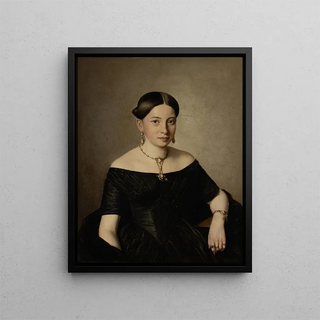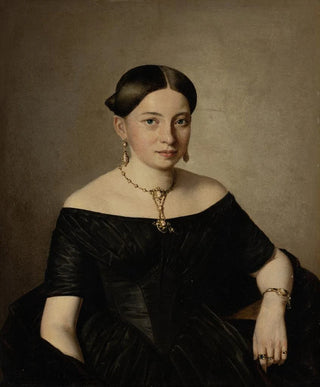Art print | Countess Dimitri Tatischeff - Ferdinand Georg Waldmüller


View from behind

Frame (optional)
In the vast panorama of art history, certain works stand out for their ability to capture the very essence of the era to which they belong. The "Countess Dimitri Tatischeff" by Ferdinand Georg Waldmüller is no exception. Created in the 19th century, this iconic piece embodies the refinement and sophistication of European high society, while revealing the undeniable talent of its creator. Through this painting, Waldmüller transports us to a world where beauty and elegance blend harmoniously, offering a fascinating glimpse into the aristocratic life of his time.
Style and uniqueness of the artwork
The "Countess Dimitri Tatischeff" is characterized by meticulous style and exceptional attention to detail. Waldmüller, a master of realism, manages to render every nuance of light and shadow with striking precision. The countess's face, delicately modeled, expresses an emotional depth that transcends a simple portrait. The sumptuous clothing, adorned with rich textures, adds a tactile dimension to the piece, while the choice of colors, both subtle and vibrant, creates an atmosphere of serenity and nobility. The background, often overlooked in other portraits of the period, is here carefully crafted, contributing to the overall ambiance and reinforcing the stature of the central figure. Every element of the composition is designed to enhance the idea of grandeur and dignity, making this work a perfect example of Waldmüller’s artistic craftsmanship.
The artist and his influence
Ferdinand Georg Waldmüller, born in 1793 in Austria, is an essential figure of the realist movement. His innovative approach to portrait painting influenced many contemporary and later artists. Waldmüller stands out for his ability to combine realism with romantic sensitivity, creating works that speak not only of appearance but also of the soul of the characters he depicts. His interest in everyday life and social classes drives him to explore various themes, ranging from noble portraits to scenes of rural life. The "Countess Dimitri

Matte finish

View from behind

Frame (optional)
In the vast panorama of art history, certain works stand out for their ability to capture the very essence of the era to which they belong. The "Countess Dimitri Tatischeff" by Ferdinand Georg Waldmüller is no exception. Created in the 19th century, this iconic piece embodies the refinement and sophistication of European high society, while revealing the undeniable talent of its creator. Through this painting, Waldmüller transports us to a world where beauty and elegance blend harmoniously, offering a fascinating glimpse into the aristocratic life of his time.
Style and uniqueness of the artwork
The "Countess Dimitri Tatischeff" is characterized by meticulous style and exceptional attention to detail. Waldmüller, a master of realism, manages to render every nuance of light and shadow with striking precision. The countess's face, delicately modeled, expresses an emotional depth that transcends a simple portrait. The sumptuous clothing, adorned with rich textures, adds a tactile dimension to the piece, while the choice of colors, both subtle and vibrant, creates an atmosphere of serenity and nobility. The background, often overlooked in other portraits of the period, is here carefully crafted, contributing to the overall ambiance and reinforcing the stature of the central figure. Every element of the composition is designed to enhance the idea of grandeur and dignity, making this work a perfect example of Waldmüller’s artistic craftsmanship.
The artist and his influence
Ferdinand Georg Waldmüller, born in 1793 in Austria, is an essential figure of the realist movement. His innovative approach to portrait painting influenced many contemporary and later artists. Waldmüller stands out for his ability to combine realism with romantic sensitivity, creating works that speak not only of appearance but also of the soul of the characters he depicts. His interest in everyday life and social classes drives him to explore various themes, ranging from noble portraits to scenes of rural life. The "Countess Dimitri






